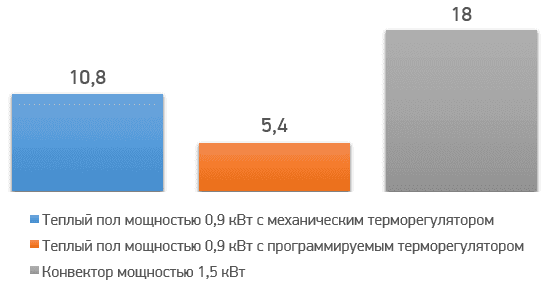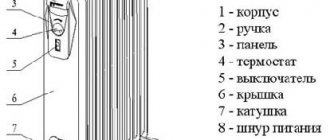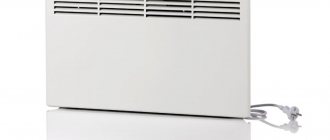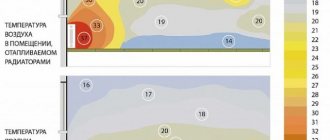Types of electric heated floors
Today there is a huge range of electric flooring systems on the market. All of them are divided into several types.
Below we will analyze in detail the technical characteristics of each type, calculate the electricity consumption depending on the type of room per 1 m2 per hour, per month. We will also find out how the topcoat affects energy consumption.
Electrical cable
An electrical cable is a wire that is laid randomly, but more often in a “snail” or “snake” pattern. The structure is filled with a concrete screed on top, which reduces the height of the room by an average of 5 cm. The specific power of such a cable is from 0.01 to 0.06 kW/m2, its choice depends on the frequency of turns.
The energy intensity of one meter of cable ranges from 10 to 60 W. To cover 1 m2 of surface, about 5 meters of wire are required, thus heating on average requires 120 - 200 W of electricity.
Thermomat
Heating mats are a structure made of cable, which is laid according to a certain pattern on a special grid. It is often mounted under a screed and is perfect for installation in rooms with high humidity.
This model is intended for rooms with low ceilings, since the thickness of the “pie” is only 3 cm. The power of the mat is up to 0.2 kW/m2.
The average consumption per square meter of a heating mat is 120 - 200 W.
Infrared film
Infrared heated floor is a thin polymer film coated with a carbon layer. When heated, carbon emits heat.
IR film does not affect the height of ceilings. On average, about 150 - 400 W of electricity is wound to warm up 1 m2 of film.
Rod floor
Rod floor - refers to the infrared type, but instead of carbon plates it contains rods. Its energy consumption is 120 - 200 W per square meter.
Calculation of electricity consumption of IR film per 1m2
It is worth understanding that each home will have its own electricity consumption. If we talk about the average electricity consumption, it varies from 10 to 60 watts per square meter of area.
For a country house, where infrared heated floors are the main source of heat, the energy consumption will be from 30 to 40 watts per square meter. In an apartment where a heated floor serves as an additional heating element, energy costs will range from 10 to 30 W per square meter.
Heating costs in a home are influenced by various factors:
- total area of premises;
- area of the floor surface covered;
- type of flooring;
- general characteristics of the room (height, wall thickness and volume of the heated zone);
- the presence of windows and doors in the room and their number;
- how much space does the furniture take up?
- additional heating methods.
If you have this data, you can make the most accurate calculation of heat generation and, accordingly, electricity consumption.
To understand how much electricity a warm floor consumes, you need to perform the calculation as correctly as possible, using film consumption of 40 Watt*m2 as a basis. It is worth understanding that after reaching a steady temperature, the infrared coating is turned on 3-4 times in one hour, since the material is heated for 3-5 minutes, after which the heating element cools down by several degrees.
ATTENTION! Calculations are carried out according to the electricity tariff for the Moscow region. which currently amounts to 5.29 rubles/kWh
Thus, if we take the film consumption of 40 W/m2, the calculations show that in one month the electricity consumption for heating a house with heated floors will be about 1648 kWh. The cost of such heating will be 8733 rubles. at the above rate.
If you use infrared film as an additional heat source at a rate of 10 W/m2, the monthly electricity consumption will be 413 kWh. The price per month will be 2203 rubles.
If the walls in the house have good thermal insulation, then less power will be needed for heating, since there will be less heat loss. For a house with well-insulated walls, electricity consumption will be no more than 30 watts per square meter.
Electric floor consumption calculation
ETP heating is effective, but too high energy consumption makes it unprofitable. Costs are calculated taking into account the operating mode and type of floor heater, otherwise the data will be unreliable.
Calculation of the total power of the heated floor
To calculate the approximate energy consumption of a heating system, you must start by determining the total power of the heated floor installed in the room (Ptot):
Рtotal = Sob * Рmax;
where: Sob – heated area of the room, free from furniture; Рmax – maximum power of underfloor heating per 1 m2.
The total power (Ptotal) is initially already indicated by the manufacturer (for example, the power of the Thermo TVK-130 heating mat is 130 W/m2).
Example:
The area of the room is 10 m2, the DEVI heating mat is installed on 6 m2. The maximum power (Pmax) of the installed heated floor is 150 W/m2.
Ptotal = Stotal * Pmax = 6 m2 * 150 W/m2 = 900 W
Type of thermostat used
The power of the heated floor consumed during the day (Pd) depends on the type of thermostat:
- with a mechanical thermostat, heated floors work on average 12 hours a day;
- programmable on average 6 hours a day, thanks to numerous modes for controlling the operation of the heated floor.
Рд = t * Ptot;
where: t is the operating time of the heated floor per day.
Example (for heated floor):
The DEVI heating mat installed indoors has a total power (Ptot) of 900 W.
1) with mechanical thermostat:
Рд = t * Ptot = 12 h * 900 W = 10,800 W = 10.8 kW
2) with programmable thermostat:
Рд = t * Ptot = 6 h * 900 W = 5,400 W = 5.4 kW
To evaluate the result obtained, it is necessary to compare the data of the heated floor with the energy consumption of an average convector. For such heating devices, there are only non-programmable thermostats with an on/off function.
Example (for a convector):
A 1,500 W convector is installed in the room. The device is turned on for an average of 12 hours a day.
Рд = t * Ptot = 12 h * 1,500 W = 18,000 W = 18 kW
The result obtained is 8 kW more than the power consumed by a heated floor with a mechanical thermostat and 12.6 kW more than that with a programmable thermostat.
Electricity consumption per day, kW
|
Cost of underfloor heating
Let's determine the cost of running a heated floor per month.
The approximate cost of 1 kW in Russia is 3 rubles. The average number of days in a month is 30. Thus:
Methodology for calculating energy consumption by type
To determine the amount of current consumed in electric floors, there are several criteria:
- level of thermal insulation of the room;
- product thickness;
- heat loss.
Calculation of energy consumption that is consumed during heating is carried out using the formula:
W=S×P×0.4 (S - area, P - power, 0.4 - coefficient of heated area).
Calculation of mats and electrical cables
To determine how much electricity a heated floor consumes, it is recommended to take into account the following factors:
- Heated area. In this case, you need to take into account the space free from furniture. As a rule, the figure varies between 12–15 m². This area will be used for laying mat or cable.
- Special wire. The power cell must have a power within 2.2 kW/h. This figure is enough to heat 15 m² of room. There are many options on the domestic market with a power of 2.3 kW or more. Such products are not needed for residential premises in the post-Soviet space, since the wires will not function at full capacity.
- Constant cable heating. This is necessary to maintain the appropriate temperature in the room. The cable must be warmed up for 20 minutes every hour.
- Maximum load. Electric floors consume approximately 1950 watts every hour based on maximum load. With this indicator, the temperature can reach 50 degrees. However, only 25 °C is considered normal. In case of maximum load, energy consumption will be 960 W.
When a home owner uses a two-tariff meter, he will be able to pay much less for energy consumption. To calculate the energy consumption during cable installation, it is necessary to calculate the length of the product. To do this, use a calculator with the following formula:
L=I/a (I – cable length, a – pitch between loops).
You can get the size of consumed resources by multiplying the calculated parameter by the cable power. As a result, the consumption per 1 m² will be displayed.
Calculation of infrared heated floors
According to calculations, it will be possible to identify electricity consumption in infrared heated floors if we take into account the level of preparation of the room. The film and its power also play an important role. If you use the equipment as an additional source, the power indicator of the electric heated floor will be 0.15 kW, and if the main one - 0.22 kW.
You can view the electricity consumption in warm film floors using the example of a room with an area of 50 m². In this case, the power of the product is within 0.15 kW. The calculation is carried out using the following formula:
W=50×150×0.4=3000 W.
The finished result will need to be multiplied by the tariff plan of the residential complex. The resulting figure will be the final indicator required for monthly payment. It is worth noting that when using the Night-Day counter, the result will be approximate. If planning and installation are carried out correctly, costs can be significantly reduced.
How to reduce resource costs
You can reduce electricity costs if you take into account all the nuances of the operation of a heated floor. If the thermal insulation of the house is insufficient, no tricks will help.
Correct installation of the thermostat
A sensor and thermostat must be installed in each room and configured separately.
How much energy a heated floor consumes depends on the type and method of installation of the control device. The recommendations are as follows:
- The settings of the electronic device are precise: the temperature can be set up to 1 degree. This is a more economical mode of operation.
- A programmable temperature sensor reduces the temperature during periods when the inhabitants of the home are not at home. This way you can save up to 30% energy.
- Mount the device in the coolest place.
- A thermostat is installed in each room, since the comfortable temperature in the bathroom and bedroom are different. If heating in different rooms is controlled by only one device, all rooms will be heated equally, and this leads to overspending.
The operation of the thermostat is adjusted using a floor sensor. Programmable can be configured to operate from 2 sensors. In this case, floor heating is regulated depending on the air sensor reading, and the floor sensor serves as a limiter and does not allow the temperature to increase above 28–30 C.
Heating of useful area
There is no need to heat the floor under furniture or equipment. Cables or IR film are laid only on open areas of the floor where a person comes into contact with the coating. This area is called useful or active.
The heating elements are mounted at a distance of at least 20 cm from the wall - the size of the usable area is reduced due to compliance with the limitation.
Multi-tariff meter
Three-tariff meter to reduce costs at night and during working hours
Two- and three-tariff meter takes into account the amount of electricity consumed depending on the time of day: during the day, at night, during the morning peak period. The cost of electricity varies at different times of the day. 1 kW of night energy costs 50–70% lower than daytime energy. In the morning and evening the price is highest.
A multi-tariff meter in combination with the programmed operation of a temperature sensor reduces the cost of night heating due to metering at a different tariff and by reducing the temperature.
Insulation of the building
Thermal insulation is the main condition for lower consumption. All elements of the structure are subject to insulation:
- poorly designed walls allow up to 30% to pass through;
- 20% of heat is lost through an uninsulated foundation;
- cold roof, even taking into account the attic, lets in up to 25%;
- a window in an old wooden frame loses up to 25%;
- another 5% disappears through the entry points of external communications;
- ventilation provides 15% of losses.
A poorly insulated building saves no more than 30% of heat. In such conditions, heating costs are enormous. On the contrary, reliable thermal insulation retains heat, like a thermos of hot tea. In mid-latitudes, during warm winters, an underfloor heater can replace a standard water system, while operating in additional heating mode.
Reducing the room temperature
The maximum permissible floor heating temperature is high - the air sensor at the outlet can show 30 C. This is a lot. According to statistics, the temperature is often set in the range of 23–25 C. In fact, a comfortable environment is maintained even at lower values – 21–22 C. Reducing heating by just 1 degree reduces costs by 5%.
Two types of heated floors
Underfloor heating is not a new idea. Even in ancient Rome, city residents built such a system under the bases of the baths, making cavities underneath them into which warm air was supplied. Thus, it was comfortable to move on the floor - my feet did not freeze.
In the modern world, the heating system has, of course, been significantly improved. Warm floors can be created using water or electricity . Moreover, almost anyone can now afford such equipment - you don’t have to be a rich person to do this, since competition and demand have done their job - you can buy and equip any floor heating system in your home for little money.
Now there are two types of systems that differ in the type of coolant. Some work due to the presence of hot water pipes, others - due to electricity. And each of them has its own advantages and disadvantages and has characteristic structural features. Let's take a closer look at them and find out which system is better and preferable in a given situation.
Power level
There are only three types of heated floors:
- cable;
- infrared rods;
- infrared film.
Each type has a number of characteristic features that can affect the energy consumption of a heated floor.
Power
May include:
- consumption level of the heating cable itself. The indicator can range from 120 watts to 2,000 watts. The step of laying the system cable will directly depend on this;
- Warm-up temperature is one of the main indicators. The maximum temperature of a film heated floor is 56°C. For the rod one this figure is 60°C. For cable heated floors 65°C. On average, the operating temperature is set to 35°C;
- the higher the resistance coefficient, the higher the flow rate;
- IR systems consume from 65 to 155 W per square meter of surface;
- IR floor consumes 130-170 W per square meter of area;
- The more powerful the floor heating system, the higher the electrical consumption will be.
What factors can affect energy consumption
If you turn to science for an answer, then first you should start calculating the heat losses of the room. This indicator is influenced by the following factors:
- climatic features of the region (the more cold days, the greater the consumption will be);
- is it planned to heat the entire room, or only maintain the required temperature (small heating, in the presence of other heating systems);
- characteristics of the owner and residents and their perception of the temperature present in the room;
- the level and quality of the existing thermal insulation in the room (are the walls, windows, doors insulated);
- type of flooring used (tiles need additional heating);
- A high-quality thermostat can save up to 30% of heat;
- number of residents. The less often people are at home, the less need there is for constant heating of the floor surface;
- whether thermal insulation was used.
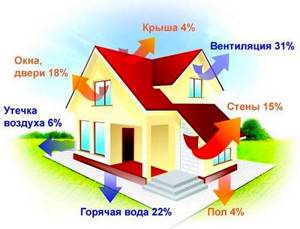
Heat loss of a private home
Key consumption indicators:
- about 200 W will be required per meter of area for basic heating;
- for easy heating or maintaining the selected temperature, you will need from 105 to 165 W per meter of surface.
As numerous studies have shown, maximum costs occur only at the stage of warming up the system and its reaching operating temperature. The system will operate for no more than 15 minutes per hour, and no more than 6 hours per day. After reaching a certain temperature, the energy consumption of the heated floor decreases, and the system only works to maintain the specified parameters. To do this, it periodically turns on and off.
Opportunity to reduce costs
In some cases, it may seem that the calculation is not very pleasant. Laying the floor itself is not only expensive, but further operation is not entirely unprofitable. However, there are certain rules and actions that will help reduce your energy costs.
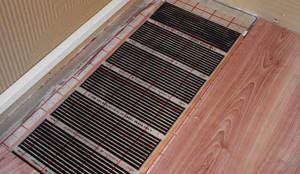
1. It is important not only to have a good heating device inside the house, but it is also important to provide high-quality insulation of the house outside. If we talk about specific numbers, heating may require 30-40% less electricity if the house is really well insulated
In this case, we can talk about savings of about a third.
2. When installing a heated floor system, it is necessary to ensure that a thermostat is installed. In this case, we can talk about not constantly turning on the system, but only when the temperature needs to be increased. If we again talk about specific numbers, the thermostat helps reduce costs by about 30%.
3. In some regions there is such a thing as a night and day tariff. When installing a heated floor in such a region, the meter should definitely be replaced. By heating a room at night using the floor, it is possible to significantly reduce costs.
4. The underfloor heating system should be installed exactly where it is needed. Thus, in those places where there is furniture or a room where the heating system is not required anyway. The absence of a heated floor will help you save on electricity.
5. If you lower the air temperature in the room by just 1 degree, it is possible to reduce energy consumption by as much as 5%. Most likely 1 degree and will not be very noticeable to others.
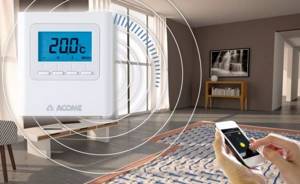
Electropol
Another type of heated floors are systems powered by electricity. They can be manufactured in three forms - heating mats, cable and infrared film . Each of these systems works by connecting to the electrical system. They do not require a water supply and do not require permission from the management company to allow their development. There is also completely no risk of flooding neighbors in the event of a problem with the system. And such floors are the best option for arranging a bathroom, kitchen or toilet.
Cable floor
The most common option for underfloor heating, powered by electricity. It is a thick insulated cable laid according to a certain pattern. The wire heats up under the influence of electricity and then releases the heat to the external environment. This is how the base heats up.
On a note! Cable flooring is a safe heating option, as it has two layers of insulation, and individual sections of wires are connected to each other with special couplings.
Such a heating system can have different power levels, making it easy to select it for a specific room. For example, 120 W/m2 equipment will be sufficient for a kitchen, and 140 W/m2 will be enough for a bathroom. This is also the cheapest option for installing a heating system in an apartment using electricity. The main disadvantage of a cable floor is the need to install a cement screed, which increases the height of the floors.
Heating mats
This is also a cable heating system, but it is unique. The fact is that thin (less than 3 mm) wires are used here, which are fixed by the manufacturer on a special mesh made of fiberglass. Typically, such floors are rolled into rolls or presented as small rugs - mats.
This version of the heating system is optimal for laying tiles, because some types of finishing coating can be immediately glued onto the heating mats. The mats are easy to install, inexpensive, often sold on an adhesive base, and are easy to cut (there are special marks on the surface of the product). In the bathroom, they can even be laid on old tiles, which reduces the amount of preparatory work.
On a note! Heating mats were invented for those rooms where it is not possible to raise the floor level by more than 1 cm.
Infrared floor
A type of electric floor heating that has become quite popular lately. The system is a film with black carbon stripes, which, when heated from the electrical network, transfers thermal energy to the finishing coating. The film can be installed under laminate or carpet and does not require a floor screed. It is flexible, easy to cut and bend if necessary.
Installation of such a system is very simple - just lay the IR film on the rough base, connect it correctly and cover it with the finishing material. The system is immediately ready for use. At the same time, dust and dirt do not arise during the work, which means that the system can be installed even when the renovation work in the apartment is almost completed.
It is interesting that carbon film is sometimes used to decorate not only floors, but also walls and ceilings. This allows it to be used as an autonomous building heating system.
On a note! The main disadvantage of IR film is its high price compared to other types of heating. It is also capable of heating all objects surrounding it, which means it cannot be placed where furniture will be placed on it.
Having considered all types of electric floors, we will try to compare them with each other. The table will help you draw the necessary conclusions.
Table. Which electric floor is better?
| Principle of comparison | IR floor | Heating mat | Cable floor |
| Installation | The material is laid directly under the finishing coating | The system is laid on the subfloor and ends up inside a layer of tile adhesive or mounted inside the screed | Installation is only possible with a cement screed |
| Maximum power, W/m2 | 220 | 160 | 110 |
| Possible flooring options | Any type of finishing material. The exception is if the coating is attached with glue. Then you need a layer of drywall between it and the IR floor | Laminate, parquet, carpet - with a screed of 2 cm thick. Porcelain stoneware slabs, tiles, wooden boards. | Any type of coating |
| Economy | High | Average | Average |
| Presence of electromagnetic field | Absent | 0.25 µT | 0.25 µT |
Video - Underfloor heating
Energy costs depending on the finish coating
When choosing a finishing material for laying on a warm electric floor, be sure to have a pictogram on the product that indicates the possibility of proximity to a heating device. More often, ceramic tiles, linoleum or parquet are laid on floor heating systems.
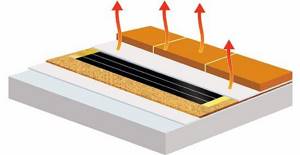
It is worth noting that the level of electricity consumption of 1 sq. m of a warm electric floor is also affected by the finishing, or rather its thermal conductivity. When choosing laminate or plank, your heating costs will increase, as they have a low degree of thermal conductivity.
But ceramics, linoleum or carpet are ideal and economically viable materials. The surface is heated quickly, and a minimal amount of resource is spent on this.
Water based floor heating system
The water is connected to the central unit, which is responsible for heating. However, when installing such a system, it is worth remembering that installation can only be done if the building is equipped with a separate riser. If it is not possible to install it, it is advised to install a boiler, which will help create a durable and environmentally friendly system. Also, this type of floor is characterized by high heat transfer, and its service life will be longer. The coolant comes from the boiler; it can be either gas or coal. The cost of this type of heating is lower than that of electric heating.
Warm floor with water heating
However, it is worth paying attention to the disadvantages of a water heating system. The price of the entire installation for floor heating with a water system is significantly higher than the cost of an electric installation. For this reason, the savings will be noticeable after some time.
This floor heating installation is more designed for rooms with a large area.
Calculation of energy costs for electric floors depending on the type of room
There are certain standards according to which a device of its own power is recommended for each room:
- in living rooms, kitchen and corridor - up to 120 W per m2;
- in the bathroom - 150 W/m2;
- in the loggia - 200 W/m2.
In addition, the power of the system is influenced by its purpose - whether it will be primary or additional heating.
For example, if a warm floor is the main source of heat in a room with an area of 20 m2, with a usable area of 8 m2, then the heat loss will be equal to 2 kW/hour. Based on these data, the power is calculated:
- heat loss/area = 2/8 = 0.25 kW/m2
If you live in a region with a harsh climate, then it is worth adding 25%.
Recommendations for selection
To make the right choice of heating system, you will have to follow certain rules. It is important to take into account the characteristics of the room - is it an apartment or a house, how is the heating installed, whether the premises have already been finished, what kind of flooring will be installed. The number of floors of the house, the materials from which it is built, and the size of the heated rooms are taken into account.
On a note! Depending on the size of the premises, the power of floor heating systems will be determined.
If you plan to install a screed in your home, then a water floor system can be installed in a private house. In large rooms it will be quite economical. Also, when installing a screed, you can use an electric cable to heat the base.
If the screed has already been poured, then a system of minimats or IR floors is used. The latter are especially relevant if all that remains is to lay the finishing floor covering. In this case, no additional or special materials are required. Also, IR floors make it possible to cover the base with such popular materials as carpet or laminate.
Attention! If heated floors will also act as a full-fledged heating system, which is undesirable, then it is recommended to use fairly powerful systems. These can be either thin film IR floors or water pipe floors.
Warm floor in the bathroom
Let's take as an example a small bathroom with an area of 4 m². Having installed a washing machine, a toilet, a washbasin with a cabinet and a bathtub, we will have approximately 1.5-2.0 m² of free space, which we will cover with warm flooring. For an easier calculation, let’s take a warm floor of 2 m² and a power of 300 W. We have a heated towel rail as an additional heat source. Each heated floor must be connected through a thermostat, which controls the floor temperature through a remote sensor. There are different thermostats and we will talk about them separately in the article Thermoregulators, but we will look at 2 types:
- Mechanical thermostat;
- Programmable thermostat.
System installation
Floor heating with such a system has significant advantages. The design must be supplemented with elements that will ensure water circulation. For example, use a pump. Additional sources of water are also used. Since the quality of heating will immediately deteriorate due to lack of water. This kind of heating must be operated rationally and not turned off during winter, since cooling and freezing of the water will be a factor of destruction.
To carry out the installation correctly, you need to first calculate everything and accurately measure the room. If necessary, when making a drawing, it is recommended to use graph paper.
To summarize, we can say that film heated floors are considered the most economical. After all, when using it, not only the floor and room warm up, but also the furniture. This kind of result is achieved thanks to infrared radiation. Ceramic tiles guarantee good heat transfer. Therefore, the material from which the floor is made also affects the efficiency.
Economical film heated floor
laminatepol.ru
Factors that reduce energy consumption
As already mentioned, when installing electric heated floors in all rooms of the apartment, the payment costs will be impressive, which will affect your family budget.
However, there are ways to reduce energy consumption:
- Carrying out high-quality insulation - good thermal insulation reduces consumption by 35 - 40%.
- Installing a multifunctional meter - the cost of electricity used at night is about 2 times lower. Moreover, heating mainly works when there are people in the house, and this is usually in the evening and night.
- Installation of heated floors should be carried out in a free area. Laying it under furniture is not only unprofitable, but also prohibited by the system manufacturer.
- Use of finishing coatings with a good degree of thermal conductivity.
- Installing a programmable thermostat, especially in residential areas, will allow you to save a third on energy.
- In sparsely inhabited rooms, not maintaining a high degree of heating is an unnecessary waste of energy.
In addition, if you reduce the heating level by just 1 degree, this will not have much effect on the atmosphere in the room, but the savings will be 5%.
Climatic conditions are also of great importance. The greater the difference between the temperature in the room and outside the window, the power consumption of electricity increases.
Thermostat is an indispensable device for reducing costs
Separately, it should be said about the thermostat - its use can reduce energy consumption by up to 40%. It is recommended to install the device in the coldest place in the room. When the temperature drops below the set value, it will turn on the heating, and when the desired value is reached, it will turn off.
For your information! Most regulators are designed for a voltage of 10 amperes; such a device can withstand a load of no more than 2300 W.
In many ways, electricity consumption is influenced by the type of thermostat, they are:
- mechanical - the design is simple and inexpensive, the daily working time is about 12 hours;
- programmable - equipped with several modes that allow you to control operation; such a device operates only 6 hours a day.
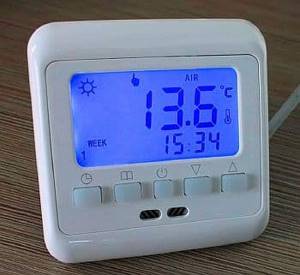
Using an example, we will consider which type of thermostat will be more economical. To do this we use the formula:
Рд = t * Ptot;
t—device operating time;
Ptot—power.
When installing a mat with a voltage of 900 W, and using a mechanical type regulator:
Pd = t * Ptot = 12 h * 900 W = 10,800 W = 10.8 kW
If a software controller is installed, then:
Pd= t * Ptot = 6 h * 900 W = 5,400 W = 5.4 kW
From this calculation it is clear that the use of a programmable controller will significantly reduce your costs.
If the warm floor acts as the main heating in all rooms, then the installation of several regulators will be required, which are connected to one centralized system.
When thinking about installing an electric floor in a house or apartment, you should make all the required calculations, taking into account the maximum load in winter. Only after weighing all the pros and cons, you need to make a decision about installing such a structure.
How can you reduce your energy consumption?
So how much energy does underfloor heating consume? And is it possible to legally reduce the existing indicator? There are only two such methods. You can install high-quality thermal insulation in the selected room or use denser (warmer) floor coverings. You can install a similar system under laminate, but it does not belong to the category of warm coatings. Such actions can reduce the electrical energy consumption of a heated floor by a third. Tile material can be used on any type of coating. It undeniably has a high thermal conductivity coefficient, which will lead to significant savings.
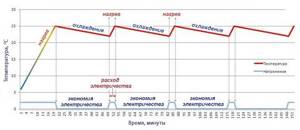
The heated floor switches off from time to time
The surface of the tile and floor is treated with glue, after which it is placed on the surface, observing the selected geometry of the pattern. Grouting is carried out only after the material has completely dried. If there is poor quality glue, an additional layer of primer is required. But the main way today is to use a high-quality thermostat. How much your system consumes will depend entirely on you.
Selecting a thermostat
How much electricity the system consumes can only be determined experimentally by carrying out the necessary calculations. To minimize the cost of paying electricity bills, it is recommended to install a thermostat. It is a device that allows you to turn on the heating at a time convenient for you at the moment when it decreases in the room. You can set the temperature yourself, based on personal preferences. Provided that the system turns on only after the surface has cooled, you can save about 40%. In this case, the sensor should be installed in the coldest place in the room.

Thermostat location
Thermostats can be:
- Sensory. They are new and allow you to control the system using a touch screen.
- Electronic. Equipped with a display that shows all available settings. It receives information using external or internal sensors.
- Programmable. Belongs to the category of electronic thermostats. Allows you to customize the system more finely, thanks to many additional functions and settings.
- Mechanical is the simplest and cheapest. Its work is completely autonomous.
Criterias of choice
It is very important to make the right choice between underfloor heating systems, water or electric. This is a responsible process, and a certain algorithm must be followed here. First you need to decide what this system will be: main or auxiliary. That is, it is necessary to take into account:
- Features of the room and its characteristics;
- Properties of electrical wiring. It is important to remember that the engineering systems of a particular room have their limits, and each can withstand one or another voltage;
- Type of flooring;
- Is there any point in installing complex controls?
In addition to analyzing the main criteria, it is necessary to make calculations, taking into account the number of floors, rooms with a large glass area, humidity and temperature levels, heat losses of the room, the thickness of the heating system itself, and much more.
Another important criterion is the manufacturer of the heated floors. For many, this is a fundamental point when choosing a material. People usually prefer well-known manufacturers as they are more reliable. Most often, high-quality systems are produced in Spain, Norway and Finland. They provide a guarantee, and their systems work flawlessly, although now you can purchase domestic heated floors of decent quality.
It's nice to know that the time has come when heated floors are available to everyone. And every home feels warm and cozy thanks to modern technologies. You just have to take the important decision seriously: which heated floor to choose. The effectiveness of using heated floors is very high. But it is important to remember that for this you need to analyze the functionality of the room and the technical characteristics of each type of heated floor. Don't forget about your own wishes. And if the question of saving comes first, then you should think about which heated floor is the most economical. If you have something to add to the article or want to leave your opinion, feel free to write about it in the comments!
polprofy.ru
conclusions
Based on the ratio of pros and cons, it turns out that it is better to install water floors in country houses. It is recommended to lay pipes in all heated rooms and connect them to the central collector. The collector equipment will allow you to regulate the supply of coolant and the floor temperature in different rooms.
Electric floors are a good option for city apartments. They can be used as a supplement to central heating, connected locally in separate rooms - bathroom, loggia, children's room - and independently from each other.
Well, it doesn’t hurt to think about it. What if suddenly there is a hurricane that cuts all the power lines? If you have gas heating and the gas hasn’t turned off, then good. If the heating is coal, or combined, and there is also an autonomous electric generator, then it’s generally good. And if not?
ks5.ru
